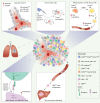Tumor heterogeneity in small cell lung cancer defined and investigated in pre-clinical mouse models
- PMID: 29535910
- PMCID: PMC5835592
- DOI: 10.21037/tlcr.2018.01.15
Tumor heterogeneity in small cell lung cancer defined and investigated in pre-clinical mouse models
Abstract
Small cell lung carcinoma (SCLC) is a fast-growing, highly metastatic form of lung cancer. A major difference between SCLC and other forms of lung cancer is that SCLC tumors often respond well to chemotherapy initially; unfortunately, resistant tumors rapidly recur. In addition, despite a large number of clinical trials with a variety of therapeutic agents, little progress has been achieved in the past three decades in improving the survival of SCLC patients. These clinical observations indicate that SCLC tumors have a high degree of plasticity and rapid adaptability to changes in growth conditions. Here we consider recent evidence pointing to several levels of heterogeneity in SCLC that may explain the ability of these tumors to adjust to different microenvironment and therapeutics. In particular, we review new data pointing to the existence of several subpopulations of tumor cells that interact with each other to promote tumor growth. We also discuss how SCLC tumors that look similar at the histopathological level may actually represent distinct subtypes of tumors and how these differences impact the response to specific therapeutic agents. A better understanding of genetic and cellular heterogeneity will guide the development of personalized approaches to help SCLC patients.
Keywords: Heterogeneity; knockout mice; neuroendocrine cells; notch, small cell lung cancer (SCLC).
Conflict of interest statement
Conflicts of Interest: YT Shue and JS Lim declare no financial interests. J Sage receives research funding from StemCentrx/Abbvie and is an inventor on patent application PCT/US2015/010650 “Targeted therapy for small cell lung cancer”.
Figures


References
Publication types
Grants and funding
LinkOut - more resources
Full Text Sources
Other Literature Sources
Miscellaneous
